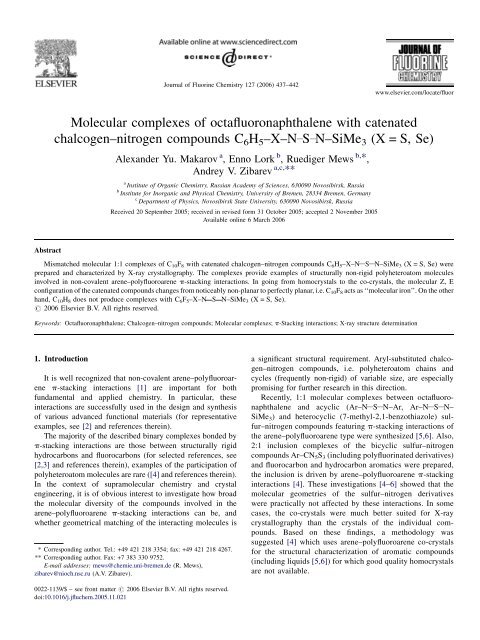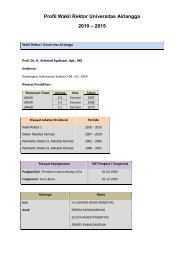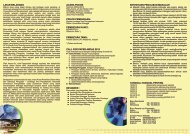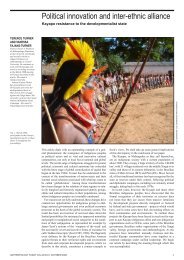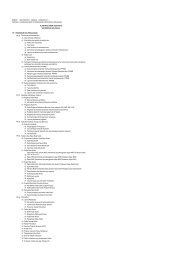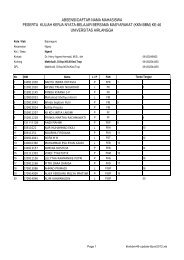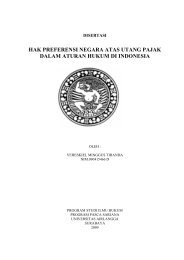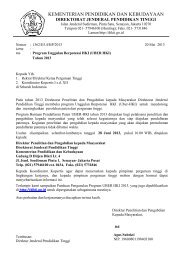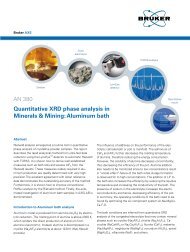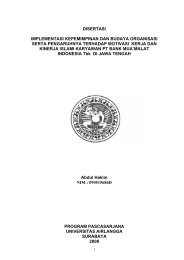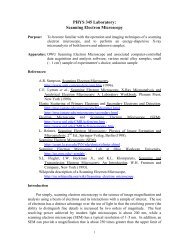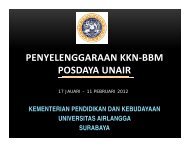Molecular complexes of octafluoronaphthalene with catenated.pdf
Molecular complexes of octafluoronaphthalene with catenated.pdf
Molecular complexes of octafluoronaphthalene with catenated.pdf
You also want an ePaper? Increase the reach of your titles
YUMPU automatically turns print PDFs into web optimized ePapers that Google loves.
Journal <strong>of</strong> Fluorine Chemistry 127 (2006) 437–442<br />
www.elsevier.com/locate/fluor<br />
<strong>Molecular</strong> <strong>complexes</strong> <strong>of</strong> <strong>octafluoronaphthalene</strong> <strong>with</strong> <strong>catenated</strong><br />
chalcogen–nitrogen compounds C 6 H 5 –X–N S N–SiMe 3 (X = S, Se)<br />
Alexander Yu. Makarov a , Enno Lork b , Ruediger Mews b, *,<br />
Andrey V. Zibarev a,c, **<br />
a Institute <strong>of</strong> Organic Chemistry, Russian Academy <strong>of</strong> Sciences, 630090 Novosibirsk, Russia<br />
b Institute for Inorganic and Physical Chemistry, University <strong>of</strong> Bremen, 28334 Bremen, Germany<br />
c Department <strong>of</strong> Physics, Novosibirsk State University, 630090 Novosibirsk, Russia<br />
Received 20 September 2005; received in revised form 31 October 2005; accepted 2 November 2005<br />
Available online 6 March 2006<br />
Abstract<br />
Mismatched molecular 1:1 <strong>complexes</strong> <strong>of</strong> C 10 F 8 <strong>with</strong> <strong>catenated</strong> chalcogen–nitrogen compounds C 6 H 5 –X–N S N–SiMe 3 (X = S, Se) were<br />
prepared and characterized by X-ray crystallography. The <strong>complexes</strong> provide examples <strong>of</strong> structurally non-rigid polyheteroatom molecules<br />
involved in non-covalent arene–polyfluoroarene p-stacking interactions. In going from homocrystals to the co-crystals, the molecular Z, E<br />
configuration <strong>of</strong> the <strong>catenated</strong> compounds changes from noticeably non-planar to perfectly planar, i.e. C 10 F 8 acts as ‘‘molecular iron’’. On the other<br />
hand, C 10 H 8 does not produce <strong>complexes</strong> <strong>with</strong> C 6 F 5 –X–N S N–SiMe 3 (X = S, Se).<br />
# 2006 Elsevier B.V. All rights reserved.<br />
Keywords: Octafluoronaphthalene; Chalcogen–nitrogen compounds; <strong>Molecular</strong> <strong>complexes</strong>; p-Stacking interactions; X-ray structure determination<br />
1. Introduction<br />
It is well recognized that non-covalent arene–polyfluoroarene<br />
p-stacking interactions [1] are important for both<br />
fundamental and applied chemistry. In particular, these<br />
interactions are successfully used in the design and synthesis<br />
<strong>of</strong> various advanced functional materials (for representative<br />
examples, see [2] and references therein).<br />
The majority <strong>of</strong> the described binary <strong>complexes</strong> bonded by<br />
p-stacking interactions are those between structurally rigid<br />
hydrocarbons and fluorocarbons (for selected references, see<br />
[2,3] and references therein), examples <strong>of</strong> the participation <strong>of</strong><br />
polyheteroatom molecules are rare ([4] and references therein).<br />
In the context <strong>of</strong> supramolecular chemistry and crystal<br />
engineering, it is <strong>of</strong> obvious interest to investigate how broad<br />
the molecular diversity <strong>of</strong> the compounds involved in the<br />
arene–polyfluoroarene p-stacking interactions can be, and<br />
whether geometrical matching <strong>of</strong> the interacting molecules is<br />
* Corresponding author. Tel.: +49 421 218 3354; fax: +49 421 218 4267.<br />
** Corresponding author. Fax: +7 383 330 9752.<br />
E-mail addresses: mews@chemie.uni-bremen.de (R. Mews),<br />
zibarev@nioch.nsc.ru (A.V. Zibarev).<br />
a significant structural requirement. Aryl-substituted chalcogen–nitrogen<br />
compounds, i.e. polyheteroatom chains and<br />
cycles (frequently non-rigid) <strong>of</strong> variable size, are especially<br />
promising for further research in this direction.<br />
Recently, 1:1 molecular <strong>complexes</strong> between <strong>octafluoronaphthalene</strong><br />
and acyclic (Ar–N S N–Ar, Ar–N S N–<br />
SiMe 3 ) and heterocyclic (7-methyl-2,1-benzothiazole) sulfur–nitrogen<br />
compounds featuring p-stacking interactions <strong>of</strong><br />
the arene–polyfluoroarene type were synthesized [5,6]. Also,<br />
2:1 inclusion <strong>complexes</strong> <strong>of</strong> the bicyclic sulfur–nitrogen<br />
compounds Ar–CN 5 S 3 (including polyfluorinated derivatives)<br />
and fluorocarbon and hydrocarbon aromatics were prepared,<br />
the inclusion is driven by arene–polyfluoroarene p-stacking<br />
interactions [4]. These investigations [4–6] showed that the<br />
molecular geometries <strong>of</strong> the sulfur–nitrogen derivatives<br />
were practically not affected by these interactions. In some<br />
cases, the co-crystals were much better suited for X-ray<br />
crystallography than the crystals <strong>of</strong> the individual compounds.<br />
Based on these findings, a methodology was<br />
suggested [4] which uses arene–polyfluoroarene co-crystals<br />
for the structural characterization <strong>of</strong> aromatic compounds<br />
(including liquids [5,6]) for which good quality homocrystals<br />
are not available.<br />
0022-1139/$ – see front matter # 2006 Elsevier B.V. All rights reserved.<br />
doi:10.1016/j.jfluchem.2005.11.021
438<br />
A.Y. Makarov et al. / Journal <strong>of</strong> Fluorine Chemistry 127 (2006) 437–442<br />
Table 1<br />
Crystal data and structure refinement for 1–4<br />
Compounds 1 2 3 * 4<br />
Empirical formula C 9 H 14 N 2 S 2 Si C 9 H 14 N 2 SSeSi C 19 H 14 F 8 N 2 S 2 Si C 19 H 14 F 8 N 2 SSeSi<br />
Formula weight 242.43 289.33 514.53 561.43<br />
Temperature (K) 173 (2) 173 (2) 173 (2) 173 (2)<br />
Wavelength (pm) 71.073 71.073 71.073 71.073<br />
Crystal system Monoclinic Monoclinic Monoclinic Monoclinic<br />
Space group P 2 1 /n P 2 1 /n P 2 1 P2 1 /c<br />
Unit cell dimensions<br />
a (pm) 583.7(2) 580.70(10) 692.0(3) 1361.2(3)<br />
b (pm) 1654.1(3) 1654.5(3) 1211.7(2) 1207.7(2)<br />
c (pm) 1359.9(2) 1379.4(2) 1340.1(4) 1397.0(3)<br />
b (8) 100.84(3) 99.630(10) 193.73(3) 106.440(10)<br />
Volume (nm 3 ) 1.2896(2) 1.3066(4) 1.0932(6) 2.2027(8)<br />
Z 4 4 2 4<br />
Density (calculated) (Mg/m 3 ) 1.249 1.471 1.563 1.693<br />
Absorption coefficient (mm 1 ) 0.473 3.093 0.375 1.930<br />
F(0 0 0) 512 584 520 1112<br />
Crystal size (mm 3 ) 0.80 0.70 0.50 0.70 0.50 0.50 0.70 0.30 0.10 0.40 0.40 0.30<br />
u range for data collection (8) 2.90–27.50 2.88–27.50 3.03–27.52 2.99–27.51<br />
Index ranges 7 h 1,<br />
21 k 21,<br />
17 l 17<br />
7 h 7,<br />
21 k 21,<br />
17 l 17<br />
8 h 1,<br />
15 k 15,<br />
17 l 17<br />
1 h 17,<br />
15 k 1,<br />
18 l 17<br />
Reflections collected 7607 11870 6324 6261<br />
Independent reflections 2967 [R(int) = 0.0455] 3007 [R(int) = 0.0403] 4861 [R(int) = 0.0249] 5026 [R(int) = 0.0266]<br />
Completeness to u8 (%) 99.9 99.9 99.7 99.2<br />
Absorption correction None Empirical (DIFABS) None None<br />
Maximum and<br />
0.7978 and 0.7034 0.3069 and 0.2207 0.9634 and 0.7790 0.5951 and 0.5923<br />
minimum transmission<br />
Refinement method<br />
Full-matrix<br />
least squares on F 2<br />
Full-matrix least<br />
squares on F 2<br />
Full-matrix least<br />
squares on F 2<br />
Full-matrix least<br />
squares on F 2<br />
Data/restraints/parameters 2967/5/170 3007/0/133 4861/5/324 5026/0/313<br />
Goodness-<strong>of</strong>-fit on F 2 1.074 1.066 1.031 1.069<br />
Final R indices [I > 2s(I)] R1 = 0.0275,<br />
wR2 = 0.070<br />
R1 = 0.0350,<br />
wR2 = 0.0878<br />
R1 = 0.0469,<br />
wR2 = 0.1098<br />
R1 = 0.0314,<br />
wR2 = 0.0733<br />
R indices (all data) R1 = 0.0305,<br />
wR2 = 0.0770<br />
R1 = 0.0427,<br />
wR2 = 0.0922<br />
R1 = 0.0610<br />
wR2 = 0.1175<br />
R1 = 0.0411,<br />
wR2 = 0.0773<br />
Extinction coefficient 0.0313 (18) 0.0068 (11) 0.011 (2) 0.0115 (5)<br />
Largest diff. peak and hole 0.273 and 0.185 0.677 and 0.888 0.237 and 0.395 0.343 and 0.748<br />
* The structure was refined as a ‘‘racemic twin’’ (73%:27%).<br />
With the present work we continue our investigations<br />
[4–6] on the ability <strong>of</strong> aryl-substituted chalcogen–nitrogen<br />
compounds to produce co-crystals <strong>with</strong> polyfluoroaromatic<br />
derivatives. Two new 1:1 <strong>complexes</strong> between octafluoronaphtalene<br />
and C 6 H 5 –X–N S N–SiMe 3 (1, X = S; 2, X = Se),<br />
i.e. between molecules <strong>with</strong> very different shape and<br />
composition, are prepared and structurally characterized. The<br />
molecular structures <strong>of</strong> the individual <strong>catenated</strong> compounds<br />
1 and 2 are also pre-sented and discussed in comparison <strong>with</strong><br />
those in the co-crystals.<br />
2. Results and discussion<br />
The chalcogen–nitrogen derivatives C 6 H 5 –X–N S N–<br />
SiMe 3 (1, X= S; 2, X = Se) were prepared from (Me 3 Si–<br />
N ) 2 S and corresponding C 6 H 5 XCl [7]. The single crystals<br />
<strong>of</strong> these low-melting compounds, as well as the single crystals<br />
<strong>of</strong> their 1:1 <strong>complexes</strong> <strong>with</strong> C 10 F 8 (3 and 4, respectively),<br />
suitable for X-ray crystallography were obtained by lowtemperature<br />
crystallization from hexane.<br />
Under the same conditions, C 10 H 8 and C 6 F 5 –S–N S N–<br />
SiMe 3 [8] or C 6 F 5 –Se–N S N–SiMe 3 [9] did not produce<br />
any co-crystals.<br />
According to the X-ray diffraction data (Table 1), in the<br />
solid state compounds 1 and 2 exist in the Z, E configuration<br />
(Fig. 1, Table 2), previously observed for substituted<br />
Ar–S–N S N–SiMe 3 derivatives <strong>of</strong> 1 (Ar = 4-O 2 NC 6 H 4 [10],<br />
2-O 2 NC 6 H 4 [11], 2-HC 6 F 4 [12]). In both cases the XNSNSi<br />
(X = S, Se) fragment is planar, the dihedral angle between<br />
the XNSNSi and C 6 H 5 planes is 27.88 and 21.378 for 1 and 2,<br />
respectively.<br />
In the <strong>complexes</strong> 3 and 4 (Fig. 2, Table 2) the Z, E<br />
configuration <strong>of</strong> 1 and 2 is retained but non-planar molecular<br />
conformations turned out to be planar, i.e. C 10 F 8 acts as<br />
‘‘molecular iron’’. Thus, the torsion angle between the NSNX<br />
and the phenyl planes (X = S, Se) reduces from 27.808 to 2.588<br />
and from 21.378 to 2.378, when going from 1 to 3, and from 2<br />
to 4, respectively. At the same time, the bond lengths and bond<br />
angles <strong>of</strong> 1 and 2 are practically not affected by complexation<br />
<strong>with</strong> C 10 F 8 (Table 2). Interestingly, in the related complex
A.Y. Makarov et al. / Journal <strong>of</strong> Fluorine Chemistry 127 (2006) 437–442 439<br />
Fig. 1. The structure <strong>of</strong> molecules 1 and 2. For selected bond lengths, bond and torsion angles (see Table 2).<br />
between C 10 F 8 and C 6 H 5 –N S N–SiMe 3 (5) the <strong>catenated</strong><br />
molecule is also virtually planar <strong>with</strong> the exception <strong>of</strong> the<br />
CH 3 groups at the Si center (compound 5 is a liquid under<br />
normal conditions and had not been structurally characterized<br />
in the individual state) [6].<br />
The <strong>complexes</strong> 3 and 4 demonstrate a face-to-face p-<br />
stacking <strong>of</strong> the aromatic rings <strong>of</strong> 1 and 2 <strong>with</strong> C 10 F 8 featuring<br />
Table 2<br />
Selected bond lengths (pm), bond and torsion angles (8) for 1–4<br />
Bond/angle 1 (X = S) 2 (X = Se) 3 (X = S) 4 (X = Se)<br />
C–X 177.1 (2) 191.2(2) 179.2 (3) 192.09 (19)<br />
X–N 167.3 (2) 183.6(2) 166.5 (3) 184.2 (2)<br />
N S 155.2 (2) 154.2(2) 156.3 (3) 154.7 (2)<br />
S N 153.8 (2) 152.1 (2) 156.1 (2) 152.0 (2)<br />
N–Si 176.7 (2) 175.9 (2) 176.5 (2) 176.19 (18)<br />
C–X–N 98.4 (2) 95.96 (9) 97.37 (16) 95.60 (9)<br />
X–N S 117.1 (4) 116.49 (12) 119.01 (18) 115.71 (12)<br />
N S N 115.9 (4) 114.79 (12) 113.31 (15) 114.56 (11)<br />
S N–Si 122.9 (3) 123.26 (13) 121.85 (14) 124.98 (12)<br />
NSNX–Ph 27.80 21.37 2.58 2.73<br />
some <strong>of</strong>fset <strong>of</strong> hydrocarbon and fluorocarbon moieties<br />
(Figs. 2–4) which is typical <strong>of</strong> the field. The dihedral angle<br />
between the planes <strong>of</strong> the c<strong>of</strong>acial hydrocarbon and<br />
fluorocarbonringsisalmostequaltozeroin3 (Fig. 3, view<br />
<strong>of</strong> the stacks formed along the a-axis), while in 4 (Fig. 4,<br />
view <strong>of</strong> the stacks formed along the c-axis) a slight<br />
inclination is observed. The arene–polyfluoroarene separation<br />
<strong>with</strong>in the stacks is in the range <strong>of</strong> 344–347 pm for 3<br />
and 348–350 pm for 4. For comparison, this separation is<br />
377 pm for the lowest-temperature phase <strong>of</strong> the benzene–<br />
hexafluorobenzene co-crystals [13], 327–352 pm for the lowtemperature<br />
structure <strong>of</strong> the C 10 H 8 /C 10 F 8 co-crystals<br />
[14] and 342 pm for the 5/C 10 F 8 co-crystals [6]. In the<br />
complex 4 the Se and C atoms <strong>of</strong> the Se–C bond <strong>of</strong> molecule<br />
2 are coordinated practically to the ring’s centroids <strong>of</strong> the<br />
neighboring C 10 F 8 molecule (this differs from mutual<br />
orientation <strong>of</strong> 5 and C 10 F 8 observed in their complex<br />
[6]), the atom-to-centroid distance is 354 and 348 pm,<br />
respectively. The complex 3 displays similar pattern <strong>with</strong><br />
correction for the shorter S–C bond as compared <strong>with</strong> the<br />
Se–C bond.
440<br />
A.Y. Makarov et al. / Journal <strong>of</strong> Fluorine Chemistry 127 (2006) 437–442<br />
Fig. 2. The structure <strong>of</strong> <strong>complexes</strong> 3 and 4. For selected bond lengths, bond and torsion angles (see Table 2).<br />
Fig. 3. View <strong>of</strong> the unit cell <strong>of</strong> 3 along the a-axis.
A.Y. Makarov et al. / Journal <strong>of</strong> Fluorine Chemistry 127 (2006) 437–442 441<br />
Fig. 4. View <strong>of</strong> the unit cell <strong>of</strong> 4 along the c-axis.<br />
3. Conclusions<br />
Two novel mismatched molecular <strong>complexes</strong> <strong>of</strong> octafluoronaphtalene<br />
<strong>with</strong> aryl-substituted <strong>catenated</strong> chalcogen–nitrogen<br />
compounds have been prepared. Significantly, they provide<br />
rare examples <strong>of</strong> flexible polyheteroatom molecules involved<br />
in non-covalent arene–polyfluoroarene p-stacking interactions.<br />
In going from the homocrystals to the co-crystals, the molecular<br />
Z, E configuration <strong>of</strong> the <strong>catenated</strong> compounds changes from<br />
noticeably non-planar to planar, i.e. C 10 F 8 acts as ‘‘molecular<br />
iron’’. Since it is known that the limiting value <strong>of</strong> a torsion angle<br />
interrupting efficient intramolecular p-overlap is only about<br />
308 [15], this structural effect might be useful for the design and<br />
synthesis <strong>of</strong> new materials based on p-conjugated molecules.<br />
It should be noted that there is a general interest to p-functional<br />
molecules engaged in anisotropic intermolecular interactions<br />
in the solid state in the context <strong>of</strong> materials science [16].<br />
4. Experimental<br />
4.1. Preparations<br />
The compounds 1 and 2 were prepared by the method<br />
described [7]. The single crystals <strong>of</strong> these low-melting compounds<br />
(1, orange prisms, mp 22–23 8C; 2, elongated orange<br />
prisms, mp 33–35 8C) suitable to X-ray crystallography were<br />
obtained by low-temperature crystallization from hexane.<br />
4.2. Complexes <strong>of</strong> compounds 1 and 2 <strong>with</strong><br />
octafluoronaphtalene (3 and 4, respectively)<br />
A mixture <strong>of</strong> 0.27 g (1 mmol) <strong>of</strong> C 10 F 8 and 1 mmol <strong>of</strong> 1 or 2<br />
was dissolved in hexane (1, 1.5 mL; 2, 1 mL) and the solution<br />
was placed in a cryostat at 30 8C for crystal growth. After<br />
crystallization the solvent was removed <strong>with</strong> a syringe and the<br />
crystals were dried in vacuum. Complexes 3 and 4 were<br />
obtained as yellow needles: 3, 0.40 g (78%), mp 50–52 8C; 4,<br />
0.25 g (45%), mp 49–51 8C.<br />
4.3. Crystallographic analysis<br />
The single crystal X-ray structure determinations (Table 1)<br />
were carried out on a Siemens P4 diffractometer using Mo Ka<br />
(71.073 pm) radiation. The crystals were mounted using KEL-F<br />
oil on a thin glass fiber. The structures were solved by direct<br />
methods and refined by full-matrix least squares against F 2 <strong>of</strong><br />
all data using SHELX-97 s<strong>of</strong>tware [17].<br />
Crystallographic data (excluding structure factors) for the<br />
structures have been deposited <strong>with</strong> the Cambridge Crystallographic<br />
Data Centre as supplementary publications no. CCDC<br />
283504 (1), 283505 (2), 283506 (3), and 283507 (4). Copies <strong>of</strong><br />
the data can be obtained, free <strong>of</strong> charge, on application to CCDC,<br />
12 Union Road, Cambridge CB2 1EZ, UK (fax: +44 1223<br />
336033 or e-mail: deposit@ccdc.cam.ac.uk).<br />
Acknowledgements<br />
The authors are grateful to Mr. Peter Brackmann for<br />
technical assistance, and to the Deutsche Forschungsgemeinschaft<br />
(Germany) and the Russian Foundation for<br />
Basic Research (Russia), for joint financial support <strong>of</strong> this<br />
work (grants 436 RUS 113/486/0-2 R and 436 RUS 17/84/<br />
04).<br />
References<br />
[1] J.R. Dunitz, A. Gavezzotti, W.B. Schweizer, Helv. Chim. Acta 86 (2003)<br />
4073.<br />
[2] I.Yu. Bagryanskaya, Yu.V. Gatilov, A.M. Maksimov, V.E. Platonov, A.V.<br />
Zibarev, J. Fluorine Chem. 126 (2005) 1281.<br />
[3] J.C. Collins, A.S. Batsanov, J.A.K. Howard, D.A. Dickie, J.A.C. Clyburne,<br />
H.A. Jenkins, T.B. Marder, J. Fluorine Chem. 126 (2005) 513.<br />
[4] C. Knapp, E. Lork, R. Mews, A.V. Zibarev, Eur. J. Inorg. Chem. (2004)<br />
2446.<br />
[5] E. Lork, R. Mews, M.M. Shakirov, P.G. Watson, A.V. Zibarev, Eur. J.<br />
Inorg. Chem. (2001) 2123.<br />
[6] I.Yu. Bagryanskaya, Yu.V. Gatilov, E. Lork, R. Mews, M.M. Shakirov,<br />
P.G. Watson, A.V. Zibarev, J. Fluorine Chem. 116 (2002) 149.<br />
[7] A.Yu. Makarov, I.G. Irtegova, N.V. Vasilieva, I.Yu. Bagryanskaya, T.<br />
Borrmann, Yu.V. Gatilov, E. Lork, R. Mews, W.-D. Stohrer, A.V. Zibarev,<br />
Inorg. Chem. 44 (2005) 7194.<br />
[8] A.V. Zibarev, Yu.V. Gatilov, A.O. Miller, Polyhedron 11 (1992) 1137.<br />
[9] A.Yu. Makarov, K. Tersago, K. Nivesanond, F. Blockhuys, C. Van<br />
Alsenoy, M.K. Kovalev, I.Yu. Bagryanskaya, Yu.V. Gatilov, M.M. Shakirov,<br />
A.V. Zibarev, Inorg. Chem. 45 (2006) 2221.<br />
[10] R. Jones, D.J. Williams, P.T. Wood, J.D. Woollins, Polyhedron 8 (1989)<br />
91.<br />
[11] A.V. Zibarev, Yu.V. Gatilov, I.Yu. Bagryanskaya, S.N. Konchenko, Polyhedron<br />
11 (1992) 2787.
442<br />
A.Y. Makarov et al. / Journal <strong>of</strong> Fluorine Chemistry 127 (2006) 437–442<br />
[12] A.Yu. Makarov, I.Yu. Bagryanskaya, F. Blockhuys, C. Van Alsenoy, Yu.V.<br />
Gatilov, V.V. Knyazev, A.M. Maksimov, T.V. Mikhalina, V.E. Platonov,<br />
M.M. Shakirov, A.V. Zibarev, Eur. J. Inorg. Chem. (2003) 77.<br />
[13] J.H. Williams, J.K. Cocr<strong>of</strong>t, A.N. Fitch, Angew. Chem. Int. Ed. 31 (1992)<br />
1655.<br />
[14] E. Lork, R. Mews, A.V. Zibarev, unpublished results, 2002 (163 K<br />
structure).<br />
[15] T.A. Skotheim, R.L. Elsenbauer, J.R. Reynolds (Eds.), Handbook <strong>of</strong><br />
Conducting Polymers, Marcel Dekker, New York, 1998.<br />
[16] P. Batail, Chem. Rev. 104 (2004) 4887 (and other articles in this special<br />
issue).<br />
[17] G.M. Sheldrick, SHELX-97—Programs for Crystal Structure Analysis<br />
(release 97.2), Göttingen University, Göttingen, Germany.


